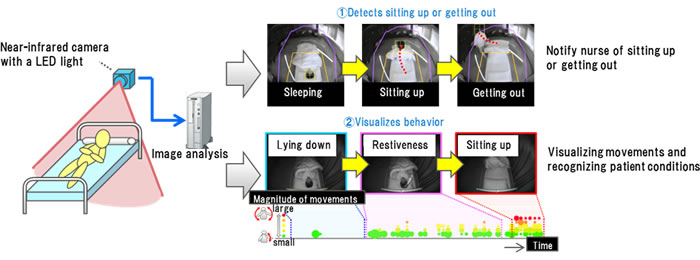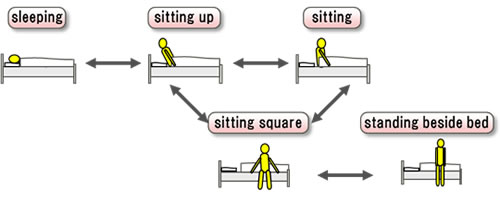Kawasaki, Japan, May 13, 2014
Fujitsu Laboratories Ltd. announced the development of a technology that uses a camera to accurately recognize the status of patients, detecting activities such as sitting up in bed, getting out of bed, or moving in bed.
There are instances in which patients in hospitals or care facilities get out of bed to walk around without nurses realizing it, then slipping and falling. They may also be in too much pain to sleep, which nurses might be late to recognize. An existing technique that uses sensors to detect the pressure of bodyweight does not always work well, giving a false alarm response to a patient just turning over while sleeping. Therefore it requires nurses to make frequent checks.
Fujitsu Laboratories has developed a technology that recognizes and tracks the patient's head with a camera, accurately recognizing when the patient sits up or gets out of bed, and also a technology that visualizes patient behavior that demands a nurse's attention.
These technologies help hospitals and care facilities provide a high level of patient protection while lightening the workload on nurses.
These technologies are being exhibited at Fujitsu Forum 2014, running May 15-16 at the Tokyo International Forum in Tokyo. Details of this technology are being presented at the SSII2014 Image Sensing Symposium, opening June 11 at Pacifico Yokohama.
Background
A nurse will typically conduct rounds to check on patients at hospitals or care facilities, but patients can get out of bed and go wandering or slip and fall when the nurse's attention is focused elsewhere, or may be in too much pain to sleep. Sometimes it can take time before the nurse notices any of these situations.
The existing technique to detect when a patient has sat up or gotten out of bed relies on sensors that detect the pressure of bodyweight. But this approach has some problems. Sometimes patients will intentionally avoid the sensor so that it does not react when they get out of bed. In addition, the sensor cannot distinguish when the patient is turning over while sleeping, or when movements by the nurse are triggering it, resulting in false alarms as the sensor cannot identify the patient's actual status. Even with these sensors, nurses still need to make frequent checks, and if anything their workload may be higher.
Issues
Other than sensors that detect pressure and movement, one possible method is to use a camera to capture images of a patient, use existing object-recognition technologies to recognize the patient's head, recognize when the patient sits up or gets out of bed based on the head's position, and calculate the scale of movements on the bed to detect when the patient can sleep or not, or other movements. This could lighten the nurse's workload while providing 24-hour monitoring, but it presents the following issues.
1. Overlooking patient sitting up or getting out of bed due to poor head-recognition accuracy
Typical object-recognition technology is programmed with data on multiple heads as learned data so that it can recognize heads with different shapes, hairstyles, orientations, and expressions. The captured image of a head is compared to the learned data to pick the head out of the image, but in many cases, these technologies will mistakenly identify pillows and the like as heads, and overlook the patient sitting up or getting out of bed.
2. Unable to quickly apprise nurse of behaviors demanding attention (sleeplessness, restiveness)
Normal patient behavior will include movements like turning over while sleeping. Existing technology does not do a good job of distinguishing normal patient behaviors from those demanding a nurse's attention.
About the Technology
Fujitsu Laboratories has developed two technologies that, combined, make it possible to monitor patients visually. The first is a sensing technology that recognizes the patient's head and tracks it to recognize when the patient sits up or gets out of bed, which can be precursors to actions such as wandering or slipping or falling. The second is a technology that detects and visualizes conditions such as restiveness or sleeplessness, which demand further attention (Figure 1).
 Figure 1: Technology of recognizing patient status using a camera
Figure 1: Technology of recognizing patient status using a camera
Increasing the detection accuracy of movements such as sitting up and getting out of bed, and of behaviors that demand attention, has made it possible to quickly grasp the patient's condition and lighten the nurse's workload.
Key features of the technologies are as follows
1. Selects learned data depending on patient states
The technology categorizes the state of a patient in bed into five categories depending on posture, and has defined a state-transition diagram that relates them (Figure 2). The appearance of the patient's head depends on which state the patient is in, so Fujitsu Laboratories defined the head detection area for each state, and generated learned data limited to the appearance of the head in those positions (such as orientation and size).
The recognition process also uses learned data where the next likely states are limited by the current state, based on the state-transition diagram. Selecting the learned data used in the recognition process in response to the patient's state results in highly accurate head recognition.
 Figure 2: patient states and state-transition diagram
Figure 2: patient states and state-transition diagram
2. Reduces false positives using motion information
Even with the selection of learned data based on patient status, the potential remains to incorrectly recognize pillows as heads. To correct for that, the technology observes points that will always move when the patient sits up or stands up, and will identify multiple regions in the image that might be the head. It will then confirm if it really is the patient's head or not when its movement is considered to be sitting up or standing up. If the candidate never moves or the movement stops after confirmation, the process will return to what it considers to be the patient's head and continue measuring all items that are candidates for the head. This way, even if a pillow is incorrectly identified as a head, the fact that it will move in ways that differ from sitting up or standing up will quickly rule it out as a head, and when the patient moves, the correct candidate will be recognized.
3. Visualizes patient behaviors demanding attention
With advice from medical practitioners, Fujitsu Laboratories defined ordinary behaviors and those demanding attention as follows.
Figure 3: Normal behavior and behavior demanding attention
| Behavior Category |
Description |
Typical Behaviors/Movements |
| Normal behavior/movement |
Normal sleeping movements |
Stirring
Turning over while sleeping |
| Behavior demanding attention |
Departure from normal sleeping movements |
Inability to sleep
Inability to rest
Disorderliness
Frequent sitting up/standing up |
These two kinds of behavior are identified based on such factors as the magnitude and frequency of the patient's movements.
The visualization displays those patient movements that are judged to be departures from normal sleeping motions with dots, using color to indicate the magnitude of the movements from great to small, and increasing the size of the dot to indicate the frequency of the detected movement over a fixed period of time (Figure 1). This makes it easier to understand those patient behaviors demanding attention.
Results
With the cooperation of Tamagawa Hospital(1) and the consent of patients and their families, Fujitsu Laboratories conducted a field trial to detect movements and visualize behaviors using this technology.
To test sensing of sitting up and getting out of bed, two patients were observed for four days each. Rising movements were observed over a total of 184 hours of observation using both the conventional pressure sensors and the new technology. The new technology was found to perform better (Figure 4).
Figure 4: Results of field trial
| Testing method |
Performance detecting getting out of bed |
False positives |
| New technology |
95% |
3 times/day |
| Pressure-sensor mat (conventional) |
77% |
11 times/day |
For behavior visualization, three patients were observed over a total of 176 hours. The visualization of behaviors demanding attention was found to perform with 91% accuracy.
Results of this behavior visualization were displayed at the nursing station, allowing nurses to easily monitor patient movements without going on rounds, resulting in a high standard of patient protection for the hospital or care facility while lightening the workload on nurses.
Future Plans
Fujitsu Laboratories is working to link the patient-monitoring system to an emergency-alert system for nurses and electronic medical record system with a goal of commercial implementation in fiscal 2015. The company is also continuing to develop this technology with the aim of expanding its scope of application to include residential services for the elderly and other in-residence nursing and care.
![]() E-mail: ms_patidet@ml.labs.fujitsu.com
E-mail: ms_patidet@ml.labs.fujitsu.com
